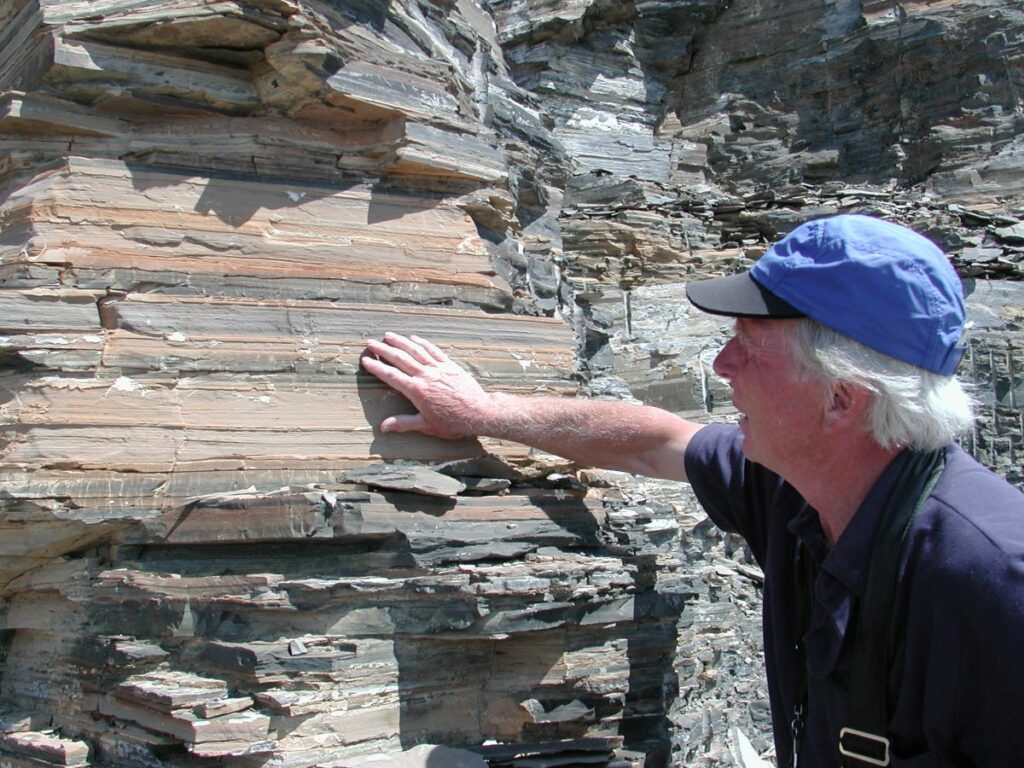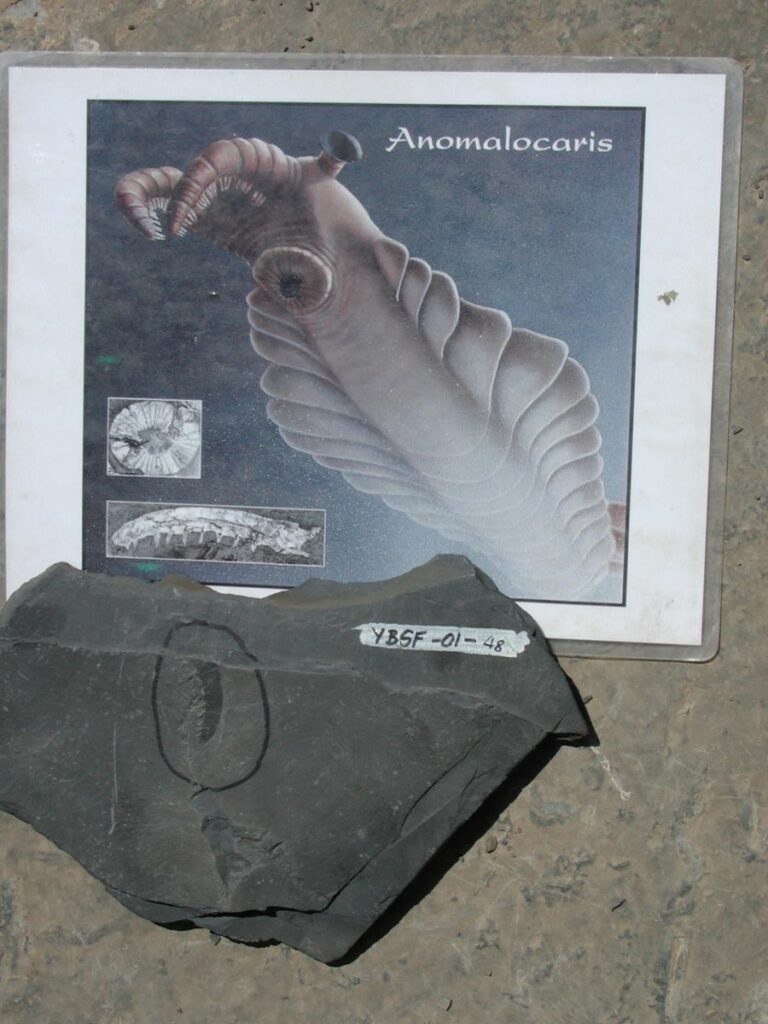High above the Trans-Canada Highway, where it cuts across the continental divide on the BC-Alberta border, there’s a small fossil bed known as the Burgess Shale. A thousand metres below, cars and trucks roll east and west along a ribbon of paving, oblivious of its existence, or its significance.
Yet this tiny paleontological site, measuring less than 200 metres in length and 30 metres in height, has been declared a UNESCO World Heritage Site. It has seen more than a century of painstaking research on its high, barren slopes. And three decades ago the celebrated palaeontologist Stephen Jay Gould wrote, “I state that the invertebrates of the Burgess Shale… are the world’s most important fossils.”
High praise indeed.

Located above the subalpine fir and larch of Yoho National Park, there’s something very profound about the Burgess Shale. To Gould, their discovery and interpretation were as important as the work done on plate tectonics, or the K-T meteor collision.
You remember the meteor theory, of course. Luis Alvarez (winner of the 1968 Nobel Prize for Physics) and his son Walter proposed the idea in 1979. It was immediately controversial, because it challenged one of the most dearly held concepts of science at the time‑that the Earth was subject only to gradual change (uniformitarianism).
A thin layer of iridium at the K-T boundary supported the theory that a meteorite had smashed into the planet. Later, the evidence mounted that it had happened near Chicxulub on the Yucatan Peninsula of Mexico, some 65 million years ago, plunging the world into a long, dark winter. This ended the Cretaceous Period, ushered in the Tertiary, and (as every school child will tell you), stopped the reign of the dinosaurs.
Meteors are strong stuff. So are plate tectonics. Can a tiny fossil patch really compete? Are the phantom images of faint, soft-bodied animals from 508 million years ago really in the same class as a mega-ton bolt of destruction from the sky? In short, what’s so special about the Burgess Shale?

To understand the significance of this tiny rock quarry between Mount Wapta and Mount Field, we have to trace the origin of life. Or lack of it. Today we are surrounded by life in every aspect of our environment, from the tiny virus that makes you sneeze, to the blue whale that weighs in at 170 tons. So it’s difficult to conceive of a time when there was no life on this planet. But for more than 80 percent of the time that the Earth has existed, there was minimal life.
Following the Earth’s formation 4,500 million years ago (MYa), the surface was just rock and sand and ice and water. Today we’re accustomed to thinking of the sea teeming with life. Yet, for four billion years, the records show there was little more than simple blue-green algae.
Then, about 541 million years ago, incredibly, magically, complex life began to develop. Just how it started, and where it started, or why it started, are subject to debate. What we do know from the fossil record is that, as the Cambrian Era dawned, life suddenly exploded in the sea.
Remember, there were few competitors. Every environmental niche was waiting to be exploited. And they quickly were. Within an astonishingly short period of time, the fossil record shows that life went effectively from “zero” to “extremely diverse.”
And here lies the paradox. Indeed, a pair of paradoxes.
The first is that if we were to take a snapshot of this sudden explosion of life, we would need to take it at a very specific time when everything was evolving. At the Burgess Shale we have just such a magical moment. The fossil beds are a record taken at precisely the right moment (mid-Cambrian, 508 MYa), something that is extremely rare anywhere on Earth.
Second, you have to realize that these early life forms were all soft-bodied. Evolution hadn’t progressed to where hard-bodied species (like clams and snails) were abundant. This was a time when worms, jellyfish and other soft fauna were populating the world’s shallow oceans. And as every junior palaeontologist knows, soft bodies don’t make good fossils. In fact, they seldom make fossils at all.
And in this paradox lies the Burgess Shale’s second claim to fame, because not only did a sudden landslide bury many species at the right moment in time, but they were buried beneath a layer of very fine anoxic silt, which preserved their most delicate and intricate soft details. The snapshot was complete.
Just as there were a pair of paradoxes at the start of the Burgess Shale, so too were there a pair of paradoxical men at the end of the story. And two more contrasting people you couldn’t imagine, partly because of their personalities, but also because of the different ages in which they lived.
Charles Doolittle Walcott was born in 1850. He wasn’t even a teenager when Charles Darwin published his most famous work. To Walcott and his generation, it was momentous, and shaped their thinking profoundly.
Walcott came from a poor upstate New York family, and received no formal scientific training. At an early age he apprenticed to a geologist, and showed rapid aptitude for the subject. In the late 1800s he studied trilobites, and steadily made a name for himself. In the Gilded Age of self-made men, Walcott was a self-made man of science.
By the time he discovered the Burgess Shale in 1907, he was one of the most important, if not the most important, scientist of his age in Washington, DC. He had headed the US Geological Survey, was secretary (read: director) of the Smithsonian Museum, president of the American Philosophical Society, president of the American Association for the Advancement of Science, was a friend of moguls Andrew Carnegie and John D Rockefeller and of Presidents Woodrow Wilson and Herbert Hoover. He was, in short, a well-connected person who spent much of his time in the corridors of power as an administrator, and very little time in the laboratory, studying fossils.
And here lies the first of the personality paradoxes. If Charles Walcott had been anyone else, he would have delegated the research to a team of underlings. But he did not. On numerous occasions between 1911 and 1923 he wrote to colleagues, mentioning that sometime “soon” he planned to put aside “the paperwork,” and get back to his real love, palaeontology. Unfortunately, it was only in the last few years of his life (1925-1927) that this was to happen, and by then, he was an old man with old ideas.
However, even if Walcott had studied the Burgess fossils when he first found them over the summers of 1907 to 1911, he would have missed their significance, because he was the product of an earlier age.
In the late 19th century, the belief was widely held that evolutionary life was “cone shaped.” What does this mean? Academics knew that life had evolved during the Cambrian Period, to fill a variety of eco-niches. These species diversified over time, so where once there might have been just one type of worm (for example), today there would be many, all filling different environs. You might come across worms at the bottom of the ocean, in the mud flats of an estuary, or at the top of a mountain, but 19th century scientists reasoned they had all evolved in a gradually increasing cone of diversity from a single genus, back at the start of the Cambrian. A diagram of this divergence would look like an upside-down cone, balanced on its tip, gradually expanding into a greater variety of species.
This belief was deeply held after Darwin’s important treatise. For Walcott, it meant that everything he found in the fossil record at the Burgess Shale had to be the forerunner of things that came later. So, when he studied his fossils and saw bizarre creatures, he made the mistake of placing them in existing classifications. If he had taken more time, he might have realised that many of his groupings relied more on faith than science.
But he didn’t. He was a busy man. Nor did any of his colleagues question him. Charles Doolittle Walcott was not a man you challenged lightly. His position in the upper echelons of science was too distinguished. And there his findings remained for half a century. Because his work supported the “cone of diversity” thinking, others based their research on his work.
Harry Whittington was a very different man from Walcott. In 1966 he led the first of two expeditions to collect fossils from Walcott’s quarry in what was now Yoho National Park. Whittington was a Cambridge University (England) academic. Like Walcott, he had spent much of his life studying trilobites. When he began re-examining Walcott’s fossil collection, the very last thing on his mind was that his work would, within a decade, stand the existing paleontological thinking on its ear, and trigger a whole new theory about evolutionary life.
Whittington started by choosing the species marrella, one that was quite common at the quarry. Using improved techniques to look at the faint (soft-bodied) imprints, Whittington slowly gained a clearer idea of exactly how the animal fitted together. And what he found puzzled him, because although Walcott had described marrella 60 years earlier as being a forerunner of a particular genus, the more Whittington looked at the specimens, the less it seemed possible.
Contrary to public opinion, science isn’t a flash-in-the-pan sort of thing. Ideas form slowly, and turn into theories only over long periods of time. Whittington barely mentioned the uncertainty with Walcott’s classification when he first published his findings. But there was a gnawing doubt, as the 1970s progressed, that gradually became a conviction. Many of the specimens that Walcott had so cheerfully shoehorned into existing classifications were, in reality, just too different, too anatomically radical, to fit into existing boxes. Harry Whittington realized that he was looking at completely new phyla.
Taxonomy is the science of classification. Over the years, our methods of classifying have changed as our understanding of the natural world has grown. Today, most scientists accept seven basic levels of classification. At the bottom of the pyramid are species (about 8.7 million, most of which are still unknown to science, with about one to two million being animals). Grouped above them come genus (plural: genera), then families, orders, classes, phylum (plural: phyla) and finally six kingdoms at the very top (animals, plants, fungi, protists, archaebacteria and eubacteria).
As you move up the ladder of classification, you find that living things share more and more in common. For example, we are mammals, who share bony skeletons with fish, reptiles and birds, which together are lumped together as vertebrates, and so on.
Moving up the ladder, the diversity reduces, so that when we reach the level of phylum, we find that there are, amazingly, only about 36 animal phyla that encompass two million species. Examples would be all the worms and leeches (annelids), all the clams, snails and squid (mollusks), all the vertebrates (chordates) and so on.
A phylum clearly includes an enormous variety of species, but they all share common traits. For instance, a frog, a bird and a fish are from the same phylum, but have diversity. They share a lot of common parts—their bones, muscles and basic organs are similar. On the other hand, a clam, a spider and a monkey are from three separate phyla, and are said to have divergence. They share few common parts.
There are big differences at the species level (diversity), but little variety at the phylum level (divergence). Why is this important? Because in the Burgess Shale (that momentary slice of time from a mountain slope in Yoho National Park) Harry Whittington found between 15 and 20 creatures so different from one another and from existing phyla, that each had to be ranked in its own, unique phylum.
What does this mean? It means that we cannot think in terms of cones of convergence any longer. There can be no “first one species of worm, later many variations,” following some lazy evolutionary path through aeons of time. Whittington and his colleagues at Cambridge turned science’s prior concepts of evolution upside down. Entire phyla had vanished, not just classes, orders, families, genera or species. Many creatures found at the Burgess Shale had no descendants.
What the Burgess Shale shows us is that life didn’t start as a few, simple creatures that gradually diversified into each and every nook and cranny of our planet. Instead, what we learn is that when life started, it began with an explosion of diversity. Then, instead of a steadily diversifying cone of evolution, the Burgess record showed that Earth has been the subject of bursts of diversity, followed by cataclysmic die outs and extinctions. Just as Einstein destroyed Newton’s orderly universe of mathematics, so Whittington destroyed the Victorian expectation of slow, progressive evolution.
This realization is best encapsulated in writer and historian Will Durant’s famous quote: “Civilization exists by geological consent, subject to change without notice.”
We should be on our guard. The Burgess Shale has spoken.
How to Visit the Burgess Shale
The site may only be visited accompanied by a guide from the Burgess Shale Geoscience Foundation, located in Field, BC. It’s situated at an elevation of almost 2,300 metres. Summers are short, and it can snow any day of the year up there. It’s also a strenuous 22-kilometre round trip hike, with a height gain of 830 metres. Physical fitness and foul weather gear are a must.
Tours fill up early, and are limited to the summer months of June through September. For full details, visit burgess-shale.bc.ca.
Bibliography:
1 Wonderful Life. The Burgess Shale and the Nature of History, Stephen Jay Gould, W.W. Norton & Co., New York, 1989.
2 Extraterrestrial cause for the Cretaceous/Tertiary extinction, Alvarez, L. W., W. Alvarez, F. Asaro, & H.V. Michel, Science, 208, pages 1095, n1008, 1980.
3 Chicxulub Crater, Mexico, and the Cretaceous – Tertiary boundary, Alan Hildebrand, Geological Survey of Canada, MIAC Conference proceeding, 1996.
4 New links between the Chicxulub impact structure and the Cretaceous/Tertiary boundary, Sharpton, V. L., G. B. Dalrymple, L. E. MarÌn, G. Ryder, B. C. Schuraytz, & J. Urrutia-Fucugauchi, Nature, 359, 819 n821, 1992.
5 The Origin of the Species, Charles Darwin, John Murray Ltd., London, 1859.
6 Rediscription of Marrella splendens, from the Burgess Shale, H.B. Whittington, Geological Survey of Canada Bulletin, 209, 1-24, 1971.


